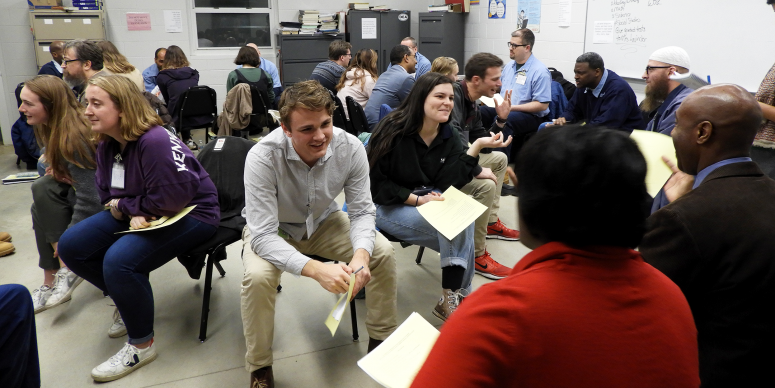Insider Perspective

From Kenyon News - March 15, 2019
Every Kenyon English seminar shares several common elements — syllabi thick with texts, close readings, thoughtful class discussions — but the special topic course “In Transit” incorporated something new: it was the first one taught within prison walls.
Throughout the fall semester, Assistant Professor of English Kathleen Fernando and 10 Kenyon students traveled to the medium-security Richland Correctional Institution in Mansfield, Ohio, to participate in Monday evening seminars with 10 inmates. In the shadow of the foreboding Ohio State Reformatory, made famous in the 1994 film “The Shawshank Redemption,” the Kenyon students and incarcerated prisoners — known as the “outside” and “inside” students, respectively — came together to learn about literature and about each other.
All of the texts used in the course addressed two themes: those of travel or movement, and of incarceration or being immobile. The syllabus for the 100-level course stretched from Charles Dickens’ 1861 classic “Great Expectations” to Tayari Jones’ 2018 novel “An American Marriage,” in which a character is wrongfully convicted of rape. Although the class remained focused on critical analysis of the texts, both the inside and outside students brought their personal experiences to class discussions and developed close friendships.
Bringing a Kenyon course inside prison walls was the brainchild of sociology major Maya Street-Sachs ’17. After completing a summer legal studies project exploring prison-exchange education, Street-Sachs identified the Inside-Out program as a model that could work at Kenyon and began searching for a faculty member to tackle the project. “When Maya presented about doing a prison course, I immediately said, ‘oh wow, this might be an opportunity for me to move out into the community and do some teaching,’” Fernando said.
Laying the groundwork for “In Transit” required more planning than an average seminar. First, Fernando attended an intensive one-week summer training course within a maximum security prison in Illinois. Then she interviewed potential outside students — all of whom had earned a high school diploma or GED and maintained a record of good behavior — and inside students in order to build a compatible class.
While the seminar was a standard three hours, Fernando and her students built in an hour of travel time each way in a College van, plus time to pass through strict prison security protocols — which reinforced the course’s theme of moving between different worlds. Fernando also adapted her teaching methods, providing her inside students with extra written feedback to help them improve their essays since they could not attend office hours.
The preparation paid off, as Fernando was impressed by the high level of discourse within the classroom. The inside students, all at least 30 years old and some from significantly more conservative and less privileged backgrounds than many Kenyon students, were able to bring new viewpoints to a typical class discussion. “These are older men who’ve spent a lot of time thinking,” Fernando said, “and so their approaches to the texts were reflective of the kind of maturity that comes with age and experience.”
“I really liked the discussions we had in the course,” said Sam Lipscomb ’19, an economics major for whom “In Transit” was his first Kenyon English class. “They were so judgment free and they were full of perspective that we wouldn’t have gotten just from Kenyon students.”
“I was excited about the opportunity to take a class with people who would bring diverse life experiences to the table,” said Schuyler Stupica ’19, an international studies major from Sylvania, Ohio. “We quickly achieved a level of trust that allowed us to discuss really serious topics, and to deal with differences respectfully and constructively. I’ve never been in a class where time flew by so quickly.” In her final paper, Stupica, who plans to pursue a career as a criminal defense or civil rights attorney, described the course as “the most impactful academic experience” she had at Kenyon.
Fernando plans to teach “In Transit” again next fall, and hopes to inspire more faculty members to adapt their own courses for the Inside-Out program. “I would like for the program to grow in a very sustainable way,” she said, adding that she’s working with Kenyon’s provost office to establish a college credit model for inside students.
On a dreary December evening, the Kenyon van traveled to Richland for the last time, now with President Sean Decatur and Street-Sachs accompanying the group to observe “In Transit” in person. It was a farewell with more finality than most, as the Inside-Out program prohibits college students and prisoners from contacting each other following the completion of the program. To ease the separation, Fernando devoted the final meeting to reflections and goodbyes, including homemade treats and a parting gift — a personally inscribed copy of “The Prison Letters of Nelson Mandela,” one for each incarcerated student. At 8:30 p.m., as the Kenyon students filed out of the classroom, more than a few shed tears.
During the course’s final session, the inside students reflected on their experiences. For some, “In Transit” enriched a repetitive institutionalized existence or reminded them of English courses they took in their lives before incarceration. “I haven’t done anything like this class in a long time,” one said. Others found comfort in the act of coming together once a week and simply talking.
“In this classroom,” one said, “we were people again.”
Photos courtesy the Ohio Department of Rehabilitation and Correction.